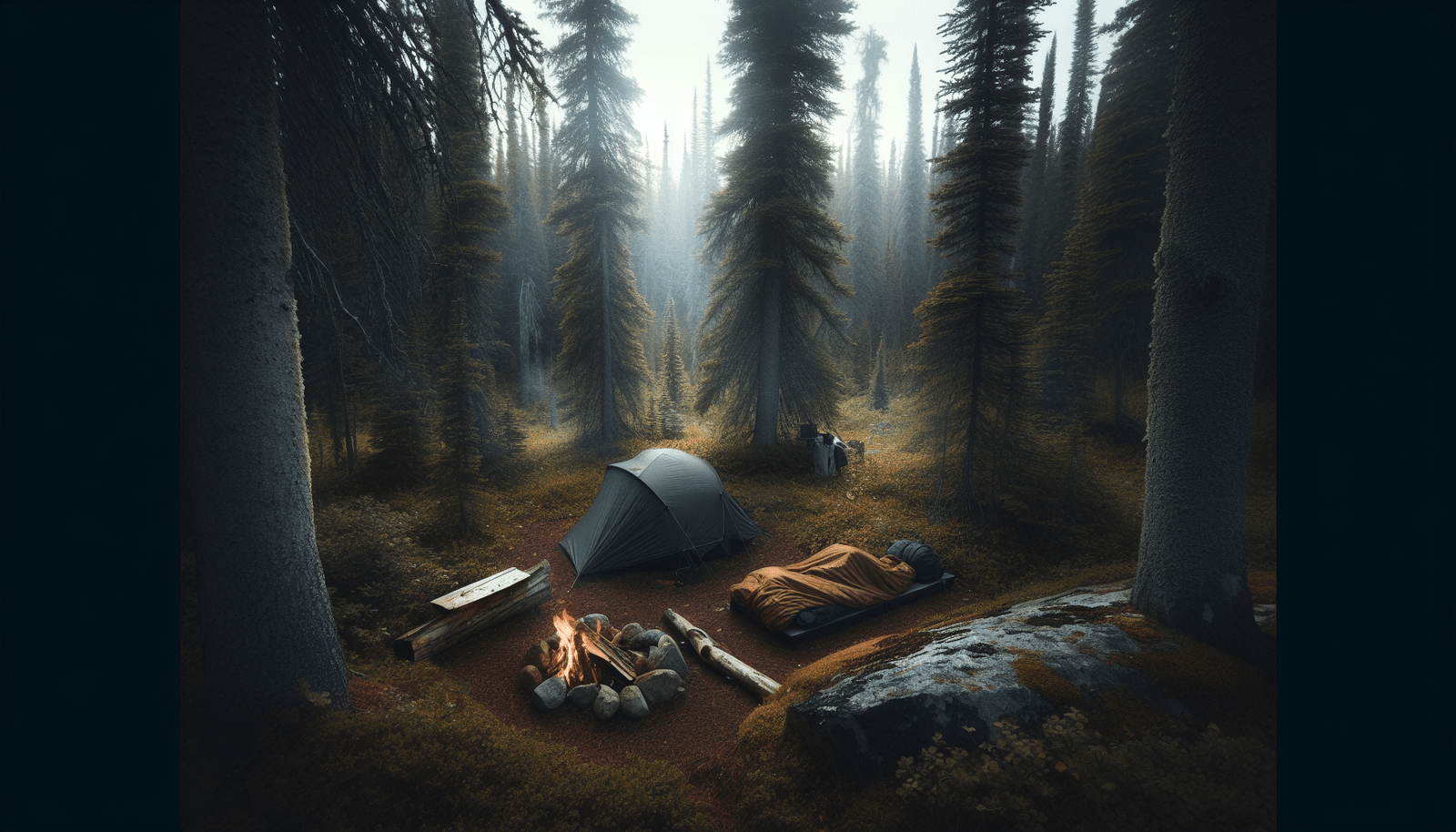You’re embarking on an adventure where luxury takes a back seat and nature reigns supreme. In the article “What Do You Call Camping With No Amenities?”, you delve into the essence of camping in its most raw and authentic form. You’ll discover the unique joys and challenges of “primitive camping,” a term that perfectly encapsulates this back-to-basics approach. With no modern conveniences, your experience hinges on self-reliance and an intimate connection with the great outdoors. Join us as we unpack what makes primitive camping a truly enriching experience, from the freedom it offers to the unexpected rewards it holds.
What Do You Call Camping With No Amenities?
Have you ever wondered what it would be like to strip back to basics and immerse yourself completely in nature? What do you call camping with no amenities?

Understanding the Basics of Camping With No Amenities
Camping without amenities is an experience that strips down the comforts of modern life to the bare essentials. In this camping style, you leave behind the conveniences of water hookups, electric outlets, and restrooms to dive into a raw and unfiltered experience in nature.
What is Primitive Camping?
Primitive camping is also known as backcountry camping or no-frills camping. When you decide to go on a primitive camping trip, you intentionally choose sites that lack the basic facilities you might find at developed campgrounds.
Features of Primitive Camping
- Secluded Locations: Primitive campsites are usually located far away from civilization, offering peace and tranquility.
- No Facilities: You won’t find running water, toilets, or electricity.
- Self-Reliance: You’ll need to bring everything you need and be prepared to deal with natural challenges.
The Appeal of Primitive Camping
Why would you trade the convenience of well-equipped campgrounds for a plot of land with absolutely no amenities? The reasons might surprise you.
Connection with Nature
Without the distractions of modern amenities, you’re free to fully connect with the environment around you. You’ll experience the sights, sounds, and smells of the wilderness in a much more profound way.
Skills and Self-Reliance
Primitive camping teaches you valuable skills like building a fire, purifying water, and navigating without GPS. These skills not only make you more self-sufficient but also give you a sense of accomplishment.
Preparing for a Primitive Camping Trip
So, you’ve decided to give primitive camping a try. But where do you start? Preparation is key for a successful and enjoyable trip.
Essential Gear for Primitive Camping
Shelter
| Item | Description |
|---|---|
| Tent | Lightweight and durable |
| Tarp | For additional weather protection |
| Sleeping bag | Appropriate for the weather conditions |
| Sleeping pad | Offers comfort and insulation |
You’ll want a tent that’s easy to pitch and strong enough to withstand various weather conditions. A tarp can provide extra protection from rain or serve as a makeshift shelter.
Cooking Tools
|-Item-| – Description-| | – – – | – – – – – – – – – – – – – -| | Portable stove | Compact and fuel-efficient | | Cookware | Lightweight pots, pans, and utensils| | Water bottles & water filter | Essential for hydration and water purification | | Food | Non-perishable and lightweight meals |
Preparing meals in the wild requires lightweight, compact, and efficient cooking gear. Be sure to opt for non-perishable food items that are easy to cook and carry.
Clothing and Footwear
Packing the right clothes is vital. Layering is essential, as weather conditions can change rapidly in the wilderness.
- Base Layer: Moisture-wicking fabric to keep sweat away from your skin.
- Middle Layer: Insulating materials like fleece or down to retain your body heat.
- Outer Layer: Windproof and waterproof jacket and pants for protection from the elements.
- Footwear: Sturdy hiking boots that offer good support and are suitable for rough terrain.
Terrain and Environment Considerations
Depending on where you choose to camp, the environment and terrain will dictate much of your preparation.
Forests
- Abundant shade and a variety of flora and fauna.
- Potential for damp conditions; prepare for muddy trails and damp firewood.
Deserts
- Extreme temperature variations; scorching during the day and freezing at night.
- Scarcity of water; carrying ample water is crucial.
Mountains
- Cooler temperatures and unpredictable weather; bring extra layers.
- Steeper and more challenging terrain; requires good physical fitness and sturdy footwear.
Safety Measures
While primitive camping is exhilarating, it also comes with its own set of risks. Being prepared and knowing how to stay safe is crucial.
Wildlife Awareness
In many primitive camping locations, you’ll share the land with wildlife. Here are some rules of thumb:
- Food Storage: Use bear canisters or hang your food from trees to keep it out of reach of animals.
- Keep Distance: Observe animals from a safe distance, and never approach or feed them.
- Know the Signs: Learn to identify animal tracks and other signs that indicate their presence.
First Aid
Carrying a well-stocked first aid kit can literally be a lifesaver. Here are some essentials:
- Bandages and gauze for cuts and scrapes.
- Antiseptics to prevent infections.
- Tweezers for removing splinters or ticks.
- Pain relievers and anti-inflammatory medications.
Knowing basic first aid can also be immensely helpful when you’re far from medical help.

Environmental Stewardship
When you camp without amenities, the importance of Leave No Trace principles cannot be overstated. Respecting nature ensures that these beautiful places remain pristine for future generations.
Principles of Leave No Trace
- Plan Ahead and Prepare: Knowing the terrain and weather conditions, to pack accordingly.
- Travel and Camp on Durable Surfaces: Stick to established trails and campsites to minimize your impact.
- Dispose of Waste Properly: Pack out all your trash, including biodegradable items like food scraps.
- Leave What You Find: Preserve the beauty of the natural environment by not taking souvenirs.
- Minimize Campfire Impact: Use portable stoves for cooking and keep fires small and controlled.
- Respect Wildlife: Observe animals from a distance and never feed them.
- Be Considerate of Other Visitors: Keep noise levels down and respect others’ experience of the wilderness.
Finding the Right Place for Primitive Camping
Not all public lands allow primitive camping, so it’s important to know where you can legally set up camp.
National Forests and BLM Land
Many national forests and areas managed by the Bureau of Land Management (BLM) in the U.S. offer ample opportunities for primitive camping.
| – Land Management Agency – | – Rules and Guidelines – | | National Forests | Dispersed camping is generally allowed unless otherwise posted. | | BLM Land | Often lenient, but always check for specific area regulations. |
Always check with the specific managing agency for the latest guidelines and any restrictions.
State Parks
While not as common, some state parks do offer designated backcountry areas for primitive camping. Be sure to check their specific requirements, as these can vary widely.
Planning Your Route and Itinerary
Mapping Your Journey
You should always have a planned route and a backup plan. Topographic maps and GPS devices can be invaluable.
Mark Essential Points:
- Possible Campsites: Identify multiple potential camping spots.
- Water Sources: Mark reliable water sources along your route.
- Emergency Exits: Plan how you’ll exit the wilderness in case of an emergency.
Duration of the Trip
Planning how long you’ll stay and estimating the time it will take to reach each point on your map helps in managing resources like food and water.
The Experience of Primitive Camping
Now that you’re out in the wild, what should you expect? A wide range of experiences awaits you, from the invigorating to the challenging.
Challenges
Weather
Always be prepared for sudden weather changes. This includes unexpected rain, high winds, or even snow, depending on the season and location.
Navigation
Stay vigilant about your surroundings to avoid getting lost. Use a combination of maps, compass, and GPS to maintain your course.
Rewards
Solitude
The peace and quiet of a primitive campsite are unparalleled. You’re miles away from the hustle and bustle of everyday life, allowing you to truly disconnect.
Physical Fitness
The physical demands of primitive camping improve your stamina, strength, and overall physical condition. Hiking, setting up camp, and even gathering firewood offer a full-body workout.
Mental Health Benefits
The solitude and simplicity of primitive camping have been shown to reduce stress, anxiety, and depression. The experience fosters mindfulness and can significantly boost your emotional well-being.
Journaling Your Experience
Consider keeping a journal during your trip to document your thoughts and experiences. This will not only help you reflect but also serve as a valuable account to refer to for future trips.
Bringing It All Together
Primitive camping offers an unparalleled way to connect with nature, learn valuable skills, and gain a deep sense of accomplishment. You venture out with nothing more than the essentials and rely on your wits and preparation to carry you through.
While it requires thorough planning and a strong respect for the natural environment, the rewards greatly outweigh the challenges. So, the next time someone asks you, “What do you call camping with no amenities?” you can tell them it’s primitive camping—a raw, refreshing, and life-enriching experience worth every moment.
Whether you’re a seasoned camper looking for a new challenge or a beginner eager to get your feet wet (hopefully not literally), primitive camping is a fantastic way to deepen your connection with the great outdoors. Happy camping!
